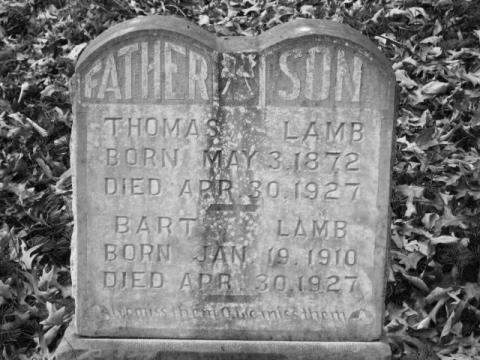Lamb Family Tragedy: Mine Disaster

Thomas and Bart Lamb's headstone Photo by Fred Gibson
By Fred and Jo Gibson
Several times a year I go to cemeteries in Chuck Swan State Forest (Central Peninsula in Union County). I’m there mostly to check the conditions of the cemeteries. While there I read some gravestones. One caught my attention. As Bonnie Heiskell Peters has said, “Cemeteries are museums without walls.”
Inscribed on this stone were Thomas and Bert Lamb,who died on the same day in 1927. Several possibilities come to mind: car or train accident or maybe a house fire? After some research, I discovered that they died in a mine explosion in Everettville, West Virginia.
Thomas Lamb was born in England on May 3, 1872. He immigrated to the United States in 1882 and married Sarah Elizabeth Thacker in Dekalb County, Alabama, on December 5, 1904. Thomas is next found in the 1910 census living in Mercer, Illinois. It was in Illinois that his son Bart was born on January 19, 1910. Thomas and Sarah had four sons and four daughters. Thomas‘s occupation is listed as coal miner. Interestingly, most of the Lamb’s neighbors were coal miners. They apparently lived in a coal company-owned community.
Then the family moved to Union County, Tennessee, in 1920. His occupation was listed as farmer. We can see from his time in Illinois, he was an experienced coal miner. We could speculate that he came from a family of coal miners in England.
As Thomas farmed land in Tennessee, he must have found life much different than living in Illinois and being part of a community that housed fellow coal miners. Perhaps Thomas missed that part of his life or it could have been that he was interested in earning extra money that only a job away from Union County could provide.
Bart was 17 when his father made the decision to travel to West Virginia and get a job in a coal mine. Thomas may have wanted his son to see another part of the world and have the opportunity to have a job that was not farming. This is only speculation, as we have no record of what propelled these two men to leave their small community. We do know that many men who farmed in Union County would often leave after crops were in the ground and go north to make “cash money.” Farmers would trade their crops for items they needed. Since all around him were farmers, it was hard to find buyers for your crop unless you took produce to a larger city. Farming was always a risky business. Sometimes the weather was fine and you brought in a bounty, but other times there was drought, insects, too much rain and much out of his control that caused no crop to be harvested that year.
Whatever the reason, we find Thomas and Bart Lamb in Everettville, Monongalia County, West Virginia in 1927. They may have been working months or only days in the Everettville Federal No. 3 Coal Mine.
However long they had been mining, they were in the mine when there was an explosion on April 30, 1927.
There was a public investigation of this accident and a 45-page report was released. The reader can read the report in its entirety if interested: https://usminedisasters.miningquiz.com/saxsewell/04-30-1927_Federal_No3…. Some of the highlights of the report were: A gas and dust explosion occurred at 3:20 p.m. where six men were killed in the tipple and 91 in the mine. Of these men, 86 were killed immediately, two traveled 500 feet before they were overcome by afterdamp and three tried to barricade themselves in a pump room but also died of afterdamp. These three men wrote messages to their families on paper from cement bags and apparently lived at least three hours. Five men in the tipple were seriously injured, nine were imprisoned in the South Main section of the mine. One of these nine men was able to go outside and lead a party of rescuers back to his co-workers. These men were supplied with an apparatus called a self-rescuer which enabled them to breathe and walk out of the mine.
A storage battery in the farthest working face in the mine ignited an accumulation of explosive gas causing the entire mine, except the south mine, to be affected.
The report found that the mine was not systematically rock-dusted. The year before, the mine was rock-dusted, but no system was set up to maintain the combustible content of the dust. Representatives of the Bureau of Mines and the Mine Safety Appliance Company arrived and with a supply of gas masks and mask canisters began the work of searching for survivors or recovering the bodies. It was determined that majority of men died from carbon monoxide poisoning. The last bodies were recovered on May 24, 24 days after the explosion.
The next time you visit a cemetery, look at the stones. You will sometimes find clues not only to the death but to the lives of those buried there. Sometimes it might be in the “words of wisdom” written on the bottom of the stone. Pay attention to the stone in its relationship with other stones. There is a lot of history in cemeteries.
- Log in to post comments



